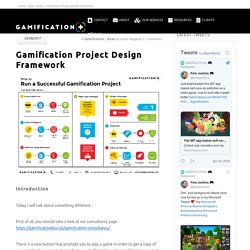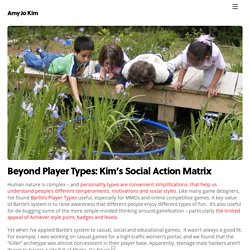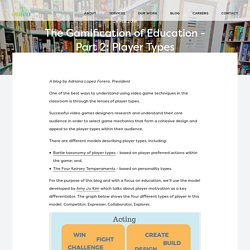

Richard A. Bartle: Players Who Suit MUDs. Richard Bartle[1] MUSE Ltd, Colchester, Essex.

United Kingdom.richard@mud.co.uk Four approaches to playing MUDs are identified and described. These approaches may arise from the inter-relationship of two dimensions of playing style: action versus interaction, and world-oriented versus player-oriented. An account of the dynamics of player populations is given in terms of these dimensions, with particular attention to how to promote balance or equilibrium. Untitled. Introduction Today I will talk about something different.

First of all, you should take a look at our consultancy page There is a new button that prompts you to play a game in order to get a copy of our gamification project design framework. That’s the subject of this blog post, the new framework we designed with Pete to share our experience on designing gamification projects and hopefully help more people design their own projects better. The need for that framework initially came from the fact that our clients were frequently asking us about our process. I will try and briefly analyse the seven stages we came up with and give you more insight on how to use this framework. Stage 1: Access Objectives As I always say to people, when we start a gamification project we need to have a clearly defined goal. - Gamify Your Life.
The Importance of Onboarding in Game Design - Game Wisdom. This past decade has given me a chance to play more unique and interesting titles than ever before.

With that said, it has also exposed one of the major failings I see from indie developers, and that is about onboarding the player to their game. Part playtesting, tutorial, and UI design, this is an important concept for any developer to learn. Show me What you Got If you never heard the term “onboarding” before, it refers to being able to get someone acclimated to something new as quickly as possible. For jobs, it’s the process of training someone and is an essential part of any profession.
The term used in the computer industry is “First-time User Experience,” and many companies have struggled with trying to make products that have the features they want, while still not being offputting to a new user. While videogames are far less serious than that, the concept is vital when it comes to making sure your players understand what’s going on. Introduction to Gamification. Balance short film won Academy Award for Best Animated Short of 1989. Tipos de jugadores Gamification: teorías Bartle, Amy Jo Kim y Marczewski.
Clasificación de los juegos según Roger Caillois - Efthalía Stamatiades - Medium. Roger Caillois fue un escritor, sociólogo y crítico literario francés que en los años 50’s contribuye al estudio del desarrollo de juegos con su obra Los Juegos y los Hombres.

En esta obra plantea que en Homo Ludens, obra de Johan Huizinga, no existe una clasificación y descripción concreta de los juegos. Huizinga habla mas bien de la importancia de la función del juego en el desarrollo de la civilización. Por esto mismo se dedica a la clasificación del juego en 4 grandes áreas. Primero hay que definir el juego, para Caillois el juego es una actividad que se caracteriza por ser libre, separada de la realidad, incierta, improductiva, reglamentada y ficticia.
·Libre: nadie puede obligarte a jugar, es una actividad libre y voluntaria. Caillois hace una clasificación primaria de los juegos, en donde existen sólo dos categorías: ·Paidia: actividades relacionadas a la diversión, con improvisación, llenas de fantasía, comunmente conocido como el juego de los niños. Gamification in Education & Learning.
Ferran Altarriba. GameThinking 3 Blueprint. A Working Theory of Game Design – First Person Scholar. Dr.

Paul Ralph is a Lecturer in Information Systems at Lancaster University & director of the Lancaster University Design Practices Lab. His work focuses on the empirical study of designers.Dr. Kafui Monu focuses on analysing, & gathering information about, employees’ decision-making processes. His new area of research looks at creating better purposeful games. When considering how to teach fundamental principles of game design, we find ourselves torn between two well-cited frameworks: the Mechanics-Dynamics-Aesthetics Framework (MDA) and the Elemental Tetrad.
While many have theorized about game design, the two most cited frameworks are MDA (Hunicke et al. 2004) and the Elemental Tetrad (Schell 2008). Mechanics describes the particular components of the game, at the level of data representation and algorithms. Figure 1: The MDA Framework (adapted from Hunicke et al. 2004) Briefly, game designers manipulate the workings of the game (e.g. rules). 1) Embedded Narratives. Works Cited. Historias que funcionan: desgranando el tema, el inicio de nuestro mundo – Game Design. Soy de esas personas que piensan que una narrativa potente vinculada a una temática reconocida juega un papel MUY importante dentro de cualquier área, y siempre que me siento a desarrollar alguna experiencia, por lo primero que empiezo es por intentar trabajar sobre un tema en concreto que me permita ampliar y estructurar un proyecto.

Programs - Game Thinking. Beyond Player Types: Kim's Social Action Matrix - Amy Jo Kim. Human nature is complex – and personality types are convenient simplifications. that help us understand people’s different temperaments, motivations and social styles.

Like many game designers, I’ve found Bartle’s Player Types useful, especially for MMOs and online competitive games. A key value of Bartle’s system is to raise awareness that different people enjoy different types of fun. - The Gamification of Education - Part 2: Player Types. A blog by Adriana Lopez Forero, President One of the best ways to understand using video game techniques in the classroom is through the lenses of player types.

Successful video games designers research and understand their core audience in order to select game mechanics that form a cohesive design and appeal to the player types within their audience. There are different models describing player types, including: Bartle taxonomy of player types - based on player preferred actions within the game; and,The Four Keirsey Temperaments - based on personality types. For the purpose of this blog and with a focus on education, we’ll use the model developed by Amy Jo Kim which talks about player motivation as a key differentiator. Amy Jo Kim's upcoming book Game Thinking will go deeper into these player types. Back to eLearning, how does this model apply to virtual classrooms?
Competitors: It is not a surprise that achievements and test scores are a motivator for this type of student. /chapter: About-Adding-Game-Mechanics / Learn JavaScript with Phaser. There are different ways you can use this book to learn to make your own games.

Normally books encourage you to start at the beginning and keep reading until you get to the end but this book isn't like that. Biggest Mistakes 2. EffectiveActionChecklist. Gamified Earth Matrix 5.